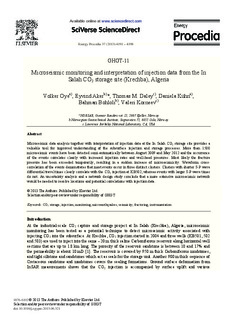| dc.contributor.author | Oye, Volker | |
| dc.contributor.author | Aker, Eyvind | |
| dc.contributor.author | Daley, Thomas M. | |
| dc.contributor.author | Kühn, Daniela | |
| dc.contributor.author | Bohloli, Bahman | |
| dc.contributor.author | Korneev, Valeri | |
| dc.date.accessioned | 2016-11-03T07:47:13Z | |
| dc.date.accessioned | 2016-12-13T09:49:07Z | |
| dc.date.available | 2016-11-03T07:47:13Z | |
| dc.date.available | 2016-12-13T09:49:07Z | |
| dc.date.issued | 2013 | |
| dc.identifier.citation | Energy Procedia 2013, 37:4191-4198 | |
| dc.identifier.issn | 1876-6102 | |
| dc.identifier.uri | http://hdl.handle.net/11250/2425008 | |
| dc.description | - | |
| dc.description.abstract | Microseismic data analysis together with interpretation of injection data at the In Salah CO2 storage site provides a valuable tool for improved understanding of the subsurface injection and storage processes. More than 1500 microseismic events have been detected semi-automatically between August 2009 and May 2012 and the occurrence of the events correlates clearly with increased injection rates and well-head pressures. Most likely the fracture pressure has been exceeded temporarily, resulting in a sudden increase of microseismicity. Waveform cross- correlation of the events demonstrates that most events occur in three distinct clusters. Clusters with shorter S-P wave differential travel times clearly correlate with the CO2 injection at KB502, whereas events with larger S-P wave times do not. An uncertainty analysis and a network design study conclude that a more extensive microseismic network would be needed to resolve locations and potential correlations with injection data. | |
| dc.language.iso | eng | |
| dc.title | Microseismic monitoring and interpretation of injection data from the In Salah CO2 storage site (Krechba), Algeria | |
| dc.type | Journal article | |
| dc.date.updated | 2016-11-03T07:47:13Z | |
| dc.identifier.doi | 10.1016/j.egypro.2013.06.321 | |
| dc.identifier.cristin | 1051669 | |
